Red Kite
Milvus milvus
Accipitriforme Order – Accipitridae Family
BIOMETRICS:
Length: 61-72 cm
Wingspan: 143-171 cm
Weight: 757-1220 g
DESCRIPTION:
The Red Kite is a superb, colourful raptor, very elegant as in flight or perched.
This species has reddish-brown plumage, with dark-streaked whitish head. Body is slender, with narrow wings and deeply forked tail.
Female is slightly paler than male.
Seen from below, the Red Kite shows a conspicuous white “hand” on the underwing. Undertail is paler. Breast and belly are reddish-brown finely streaked black.
Bill’s base and eye-rings are yellow, as legs and talons. Eyes are amber.
Fr: Milan royal
All : Rotmilan
Esp : Milano real
Ital: Nibbio reale
Nd: Rode wouw
Russe: Красный коршун
Sd: Röd glada
Photographers:
John Anderson
John Anderson Photo Galleries
Nicole Bouglouan
PHOTOGRAPHIC RAMBLE
Text by Nicole Bouglouan
Sources:
HANDBOOK OF THE BIRDS OF THE WORLD Vol 2 by Josep del Hoyo-Andrew Elliot-Jordi Sargatal - Lynx Edicions - ISBN: 8487334156
GUIDE DES RAPACES DIURNES – Europe, Afrique du Nord et Moyen-Orient de Benny Génsbol – Delachaux et Niestlé – ISBN : 2603013270
THE COMPLETE BOOK OF BRITISH BIRDS – Written by “Royal Society for the Protection of Birds” experts - Préface de Magnus Magnusson - Michael Cady- Rob Hume Editors - ISBN: 0749509112
THE HANDBOOK OF BIRD IDENTIFICATION FOR EUROPE AND THE WESTERN PALEARCTIC by Mark Beaman, Steve Madge - C.Helm - ISBN: 0713639601
Pájaros de España (JL Beamonte)
BirdLife International (BirdLife International)
Juvenile is paler, but with darker head.
The subspecies M. m. fasciicauda found in Cape Verde Islands is smaller and darker.
VOICE: SOUNDS BY XENO-CANTO
Red Kite is usually silent. When in flight, it utters a typical high-pitched shrill, a mewing “piii-ooo”, often followed by “piii-ooo-iii-ooo-iii-ooo” rising and falling.
When excited or alarmed, or during the courtship displays, calls are higher-pitched “kiou-ki-ki-ki” or “rriu-rri-rri”.
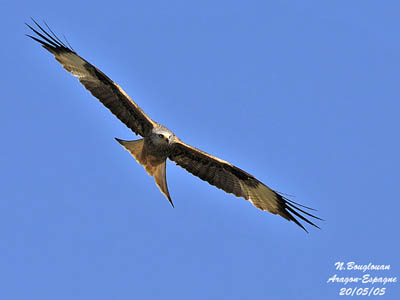
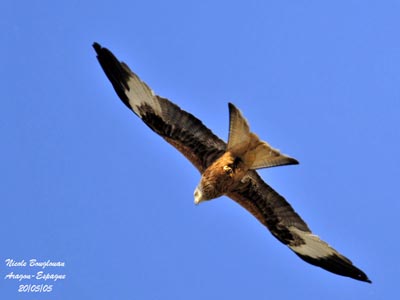
HABITAT:
Red Kite favours open forests, scattered woodlands or thickets with nearby grasslands, cultivated areas, and heath or wet areas.
RANGE:
Red Kite breeds only in Europe. It is found in Wales, southern Sweden and northern Baltic States. It is also present in France and Spain. It occurs in Mediterranean islands, Italy, the Balkans and SW Russia.
We find a population in Cape Verde Islands (M. m. fasciicauda).
The northern and centre populations migrate southwards in winter, but more and more birds become resident. However, juveniles perform post-breeding dispersion.
The migratory birds winter mainly in Spain.
BEHAVIOUR:
Many pairs are sedentary and remain all year round on their breeding areas.
The Red Kite hunts mostly in open areas, flying low from the ground. Although being mainly a “plain-hunter”, it often perches in trees for long time with fluffed plumage, almost sleeping in appearance. It may be very quiet sometimes, with motionless wings in the air, watching for prey below.
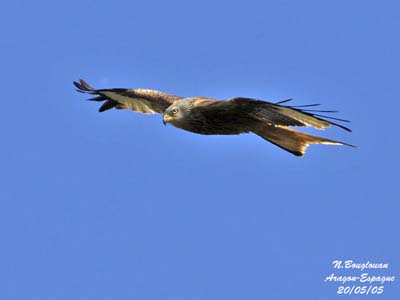
It is able to catch fairly large and agile birds such as pigeons and jays. If some carrion is detected, it circles slowly just above before to land nearby.
However, if a living prey is detected, it dives bomb with the legs held forwards just before landing, to catch it with the talons.
But this raptor is less agile in this practice than other birds of prey. Its best chance is the surprise, giving it better results.
It may eat the preys while flying. This bird has been observed eating a mouse held in the talons while flying, giving it repeated pecks!
When the breeding season starts, both mates display above the future nest-site, circling high in the sky, performing chases and grasping their talons while in flight.
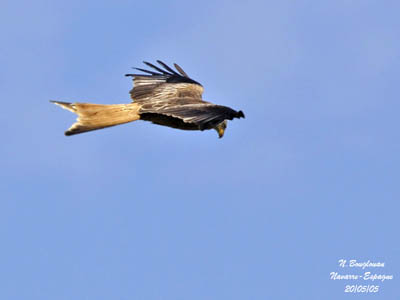
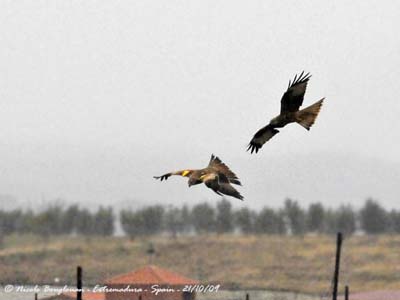
FLIGHT:
The Red Kite flies in wide circles, as well in mountainous areas as in plains. It performs slow, regular wing-beats, following a flight path while watching attentively to the ground, frequently circling at medium height above rubbish-dump or carrion where several vultures and crows are already gathered.
It often rises at great height with large turns, taking advantage of thermals, while the long tail moves sideway as a rudder.
Its flight depends on the weather conditions, and sunny days instead clouds and rains are mostly required.
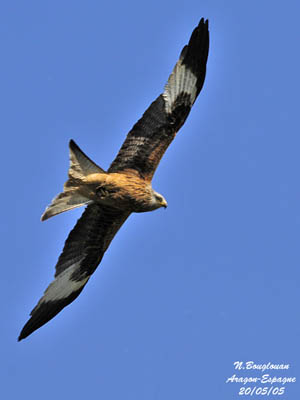
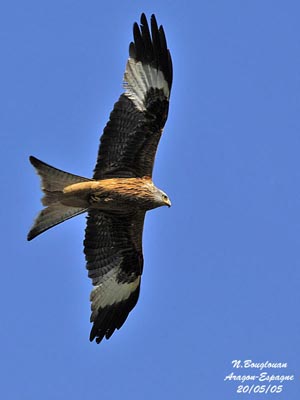
REPRODUCTION:
Breeding season occurs between March and May.
Mates pair for life. The same nest-site is reused year after year, and may size about ten kilometres in diameter.
Red Kite’s nest is usually placed in tree, between 12 and 15 metres above the ground. Abandoned crows’ nests are often used, arranged by both adults or they build their own nest. Construction starts in late March. The bad weather may delay the transfer of nest-materials until April, but then, the good weather accelerates the work.
Nests can be very bulky. They are made with short sticks (30-50 cm). The interior is lined with dry grasses, and 2-3 days before the laying, adults add sheep wool.
We can find occasionally several types of items such as bits of plastic, coloured rags and papers. At the beginning, the nest is cup-shaped, but quickly, the cup becomes flatter, ending in a platform of sticks and debris. Parents always bring materials during the incubation and the rear of the youngs.
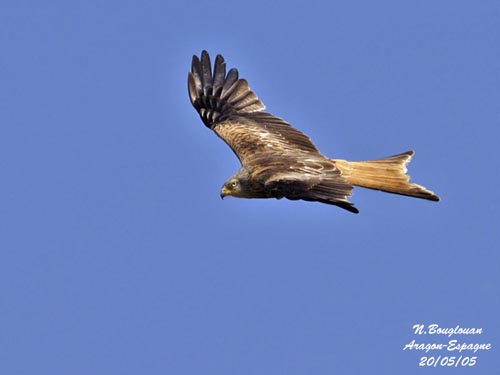
Female lays 1(rare) to 4 eggs, at 3 days intervals. Eggs are glossy white, with reddish or purple speckles. Incubation by female starts with the first egg laid. Male may replaces her occasionally, but only for half an hour.
Incubation lasts 31-32 days for each egg, giving about 38 days at the end. The female is fed by the male during this period.
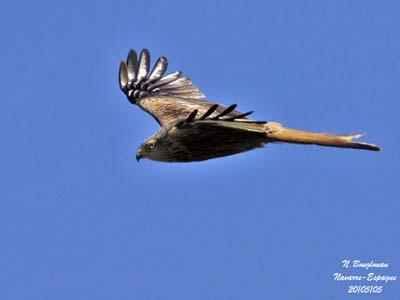
Chicks are covered in down during two weeks. The head is creamy, whereas the back is pale brown and underparts creamy-white. At 28 days of age, feathers are growing well. The last days, the young feed directly the preys brought by their parents. Their first flight occurs about 48-50 days after hatching.
They reach their sexual maturity at 2 years, but usually, they do not breed before 7 years. These raptors may live about 25-26 years in wild.
DIET:
The Red Kite has varied diet. We can find several food items in the nest, such as small mammals (mice, hedgehogs, weasels and young rabbits), birds of all sizes, from magpie to pigeon, and reptiles, frogs, lizards, fishes, carrion and insects. Its preferred food is the mole cricket. Its diet includes 50% of invertebrates.
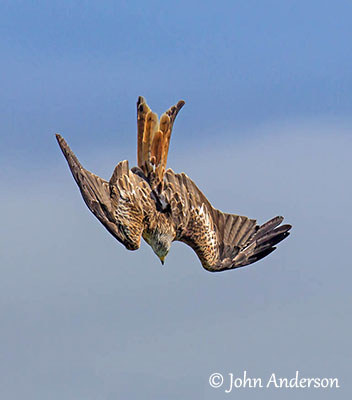
PROTECTION / THREATS / STATUS:
Collisions with electric wires involve the death of the Red Kite. Corvids destroy the eggs and eat the chicks. Abundant rains may be responsible of nest-failure, by eggs’ cooling. The important use of pesticides involves sterility.
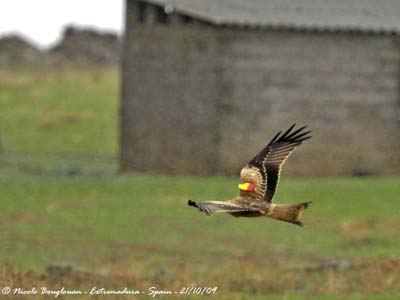
Red Kites suffered heavy declines until the 19th century, due to persecutions and poisoned baits. Protection measures involved fairly good results, and recovery of several populations occurred.
But the previous threats still continue, to which we have to add the elimination of rubbish-dumps, and always persecutions.
This Red Kite has been ringed in OLBY, in the Puy-de-Dôme (France) in June 2009.
Seen first in Castilla y León (Spain) before he reaches Extremadura.
Picture taken in October 2009 in Extremadura